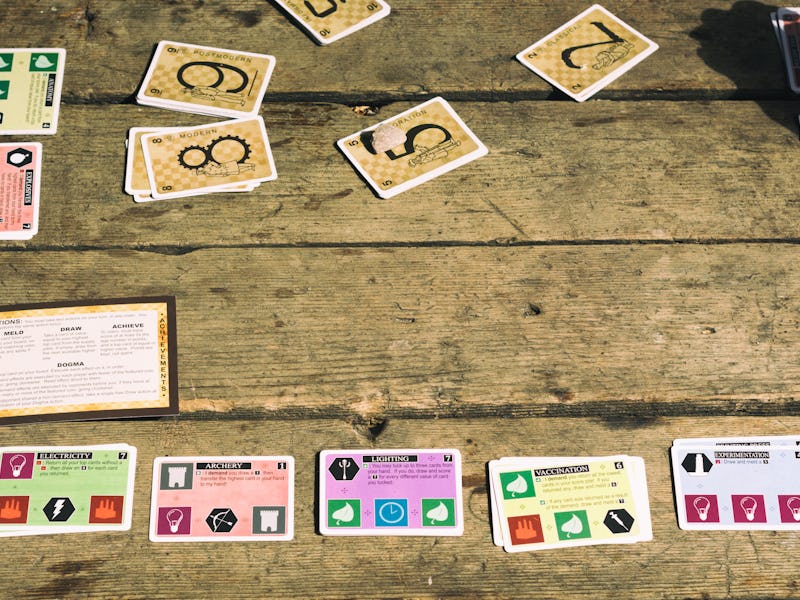This Card Game Could Change Your Understanding of History
Innovation covers 10,000 years in 45 minutes.

For an age that’s obsessed with futurism, there are few better tabletop games than the 2010 masterpiece Innovation. The gameplay itself is engaging: a sequence of tactical choices, combined with luck, that lead to countless variations. But it’s the historical implications of the thoughtfully designed system that make it special.
Play Innovation and you may realize
- that technology is the defining factor of every age.
- that power is determined by random distribution of resources and intelligent use of them.
- that technological progress is accelerating.
- that we’re living in end times.
Innovation was created by Carl Chudyk, a designer who won acclaim in 2005 with Glory to Rome. To make Innovation, Chudyk turned to a 2004 textbook, The History of Science and Technology, by Bryan Bunch and Alexander Hellemans, which, over 800 pages, discusses the biggest innovations from prehistory to the information age. (That same book was the basis of an extensive analysis of technological progress by geneticist Jan Vijg.)
In Innovation, players are dealt cards with technologies on them, starting with prehistoric ones like agriculture, the wheel, and city states. Players use abilities on each card to score points, claim achievements, and unlock new tech. Each card also features abilities tied in some way to the technology: For example, archery lets you seize technology from an opponent, while writing unlocks more advanced technology.
Archery is a prehistoric technology that can be used to seize valuable cards.
Writing is a prehistoric innovation that lets you unlock more advanced technologies.
As the game continues, players encounter the biggest innovations of every age. Below we’ve listed the nine ages after prehistory, along with the dates ascribed to them in the textbook, and some innovations from each. Some of these innovations are inventions, while others are systems of thought and shifts in the way society is structured.
The whole thing is a wonderfully simple overview of human history — and one that makes clear how technological progress is speeding up.
- The Classical Age (600 BCE to 529 CE) features mathematics, philosophy, and canal building …
- The Medieval Age (530 through 1452) has alchemy, medicine, and the compass …
- The Renaissance (1453 through 1659) has perspective, anatomy, and gunpowder …
- The Exploration Age (1660 through 1734) has chemistry, coal, and banking …
- The Enlightenment (1735 through 1819) has atomic theory, canning, and emancipation …
- The Romance Age (1820 through 1894) has the railroad, refrigeration, and evolution …
- The Modern Age (1895 through 1945) has flight, quantum theory, and skyscrapers …
- The Postmodern Age (1946 through 1972) has suburbia, computers, and satellites …
- The Information Age (1973 through today) has A.I., the internet, and bioengineering …
Things get crazy when you reach the information age.
Each play through the game suggests a new variation on how history might have unfolded — like the computer game Civilization, but more conceptual. In one, a scientifically advanced society with a lot of gold might get demolished by monotheistic pirates. In another, an early discovery of coal might secure world domination.
One card, fission, will on rare occasions trigger what can only be interpreted as nuclear apocalypse: All players remove all cards from their hands and boards and score piles and continue the game with the odd assortment of ancient and modern technologies that remain.
The game ends when various winning conditions are met, including if any player attempts to draw a card beyond the information age. Whether this is Chudyk’s commentary on the singularity or some other imminent end to the human era is uncertain, but for those looking at the game abstractly, the metaphor is clear.
History geeks and game geeks will find further pleasure in two expansion packs.
Innovation: Echoes of the Past introduces several new game mechanics and more technologies, many of them surprising. Chopsticks, the flute, perfume, and soap are some prehistoric breakthroughs that offer subtle and at times powerful abilities. Some of these you might have to look up, like the classical technology of chaturanga — an ancient strategy game — or the exploration age technology of the palampore — a dyed cotton bedspread.
Things get even weirder in the Echoes of the Past expansion pack.
Innovation: Figures in the Sand adds several more mechanics and a set of historical individuals who can alter the rules of the game. From the prehistoric age, Imhotep, Hammurabi, and Daedalus are well known, at least in the West, but Sneferu, Sunshu Ao, and Huang Di are not. Historical knowledge plays little to no role in the game, but dominate an era with the help of Amina Sukhera, and you may want to know who she is — she’s a Muslim warrior queen who introduced kola nuts into cultivation.
What other game lets you play as Queen Amina?
Innovation is best played with 2 to 4 people and takes 30 to 90 minutes, depending on expertise. New players who take the time to learn the rules can play tactically from the start, despite not knowing all the technologies in the game. The same could be said, perhaps, of life and history.
Buy a copy of the game here. Play the janky online version here. Also check out “Glory to Rome” and Chudyk’s latest game, the Buddhist-temple-themed “Mottainai.”
Owlboy is the little game that could. Check out this video of the game’s 10-year journey.